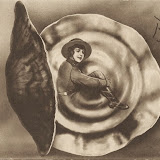Portraits of
forgotten stars who died young
“One short sleep past, we wake eternally,
And Death shall be no more; Death, thou shalt die.”
And Death shall be no more; Death, thou shalt die.”
John Donne
The history of the silent cinema is littered with young corpses,
especially suicides. A very few achieved a kind of immortality through dying:
Rudolph Valentino springs immediately to mind, but for most who died young,
death brought more than a figurative long silence. They were soon forgotten. It
is unfair to expect people born decades after they died to remember who they
were, but fame, we are told, is somehow eternal. And we are so often being
asked to imagine perpetually sunlit fields where the dead stars wander in a
kind of bliss, pausing only to look down upon us indulgently. Among these
portraits Pearl White’s is the only name I was familiar with before I bought
the photo. Saying that, the image I had of her was of a woman tied to rail
tracks as the steam engine bore down, and I cannot remember I saw that in one
of her films or got it from Rocky and
Bullwinkle. One’s memory doesn’t have gaps so much as rough patches, don’t
you find? In any case, Ms White’s story is sad and we should not make light of
it. In the early years of silent film she did her own stunts. Having been a
bareback rider in the circus she didn’t think much of jumping from heights and
rolling out of moving vehicles but she broke bones in the process, with the
result that she took to painkillers and alcohol, with the extended result that
she died from liver failure aged 49.
Who today knows anything of Lillian Hall Davis? Not me – at
least, not until I found this photo, yet we read that for a time she was one of
budding director Alfred Hitchcock’s preferred actresses and starred in his
third and fifth films, The Ring and The Farmer’s Wife; films that British
cinephiles hold as keys to understanding everything he did that followed.
Some of us can imagine a suicide’s final minutes; the
preparation and the execution. What remains utterly mysterious are the days
leading up to that; the bleakness, the compact someone makes with themselves.
Lillian Hall Davis’s death was particularly horrible. She slashed her wrist and
her throat then put her head in a gas oven. Such determination is terrifying.
In the early 1920s Bruno Kastner was a huge star in Germany,
with women. Men found it hard to reconcile his attractiveness with his
self-evident anti-masculinity. I mean to say; what are the frauleins thinking
when a fellow doesn’t have biceps and can’t down three beers without needing a
bathroom break? Like Lillian Hall Davis, he was a victim of a sudden shift that
saw him regarded as Germany’s most popular cinema hero one year and then a
couple later being reduced to selling photo opportunities for a few pfennigs.
In Kastner’s case the cause was self-evident. He stuttered, which obviously was
an issue when cinema turned to sound, and a source of great humour to the beery
chaps when they gathered at the bar after a day blasting at quail with shotguns.
One of his last films was Angst,
based on a Stefan Zweig novel, and in a scene that could have belonged in the
Zweig inspired Grand Budapest Hotel,
in 1932 he travelled up to the resort of Bad Kreuznach with its gingerbread
houses surrounded by forest, booked into a hotel and hanged himself.
If you tell Americans that in the early 1920s Gösta Ekman was
the biggest star in Swedish cinema, they’ll probably laugh and say, ‘yeah,
right. Swedish cinema.” The phrase
“1920s Swedish cinema” may not mean much to most Americans but there are some –
usually thin, pallid young men with skin conditions – who know that in the
1920s Swedish cinema was everything Hollywood was supposed to be. While Chaplin
was pumping out one-reel soufflés, the Swedes were filming two hour long epics.
When the Americans imagined the emotion expressed in a starlet’s batting
eyelashes said it all, the Swedes were dredging the human soul for every bit of
squalor they could find. What would you expect? This was the land of the
sunless winter. Henrik Ibsen and Hedda Gabler were neighbours just across the
border. Ekman was an artist. He made that clear to the point he was willing to
neglect his family for his art. In 1926 he went to Germany to star in one of
the expressionist classis, Faust. While
working long hours, he started taking cocaine to deal with fatigue. Twelve
years later he died of a heart attack after years struggling with chronic
addiction. He was 48 years old. Tears of a clown.
In late September of 1912 a funeral procession trundles
through the streets of Paris. The coffin is covered in wreaths but it is
considered “tenth class”, or ‘very simple’ in Parisian terms. Among the
mourners at the head are a Rothschild, a Baron Ceccaldi and several others
whose surnames are enough to impress the reporters gathered on the sidewalk.
Some of the press have already filed stories expressing outrage that the police
would dare question France’s most exemplary citizens on this sombre day. As for
the raids on the drug dens; why implicate the nation’s best names when,
clearly, her demise was her doing?
Inside the coffin is Pierrete Fleury, 22 year old aspiring
dancer who, it is true, wasn’t a household name until today. What went on in
her house in Le Vésinet, a wealthy suburb on the outskirts of Paris, has
scandalized a city that likes to think it has seen it all. For months a
procession of limousines drove out to the house and unloaded their human
contents on the steps. Once inside, the sons of France’s finest indulged in
behaviour that appalled the staff. Opium, cocaine, sex, more opium, more
cocaine, more sex: the place must have resembled a Normandy farmyard at feeding
time. Let’s not hold back on Pierrete; she and the other dancers living at the
house had instigated this scenario but just a couple of days ago, one of the
male staff members alerted that she hadn’t answered the maid’s knocks, took a
ladder and climbed up to look in her window. Her cold body lay on the bed, her
face wrapped in an ether soaked sheet. Technically it was filed as accidental
suicide. As usual, the Government vowed that no one would be spared in its
efforts to put an end to these notorious drug dens.
It is tiresome to read yet another claim that the behaviour
of Someone Cyrus or Someone Kardashian is liberating for women, especially when
it’s a woman writing. Said perp should have to spend a week, at least, walking
around with a placard that reads: ‘Culturally speaking, I’m really uneducated’.
Diana Karenne, (born Leucadia Konstanti in Danzig, 1888), was
a star of Italian, French and German films in the 1910s and 1920s. Her artistic
control extended to directing and producing and she organized her own
promotions down to designing the posters. Add to that the detail that she often
played a woman with a pragmatic attitude towards her lovers and we have the
makings of a feminist icon – except we don’t. Where in all the guff about
post-modern feminism are the discussions about women like Karenne and Fern
Andra? If the Ms Someones have it so difficult today, what was it like back
then, when women couldn’t even vote? Well, there is a situation with Ms Karenne
that some posing as feminist intellectuals could have a problem with, but only
if they wanted to. In the 1930s, when Germany was the centre of Europe’s film
industry, Ms Karenne moved to Berlin and continued her success until she
married and moved with her husband to Aachen, where she turned her attention to
painting and poetry. In July 1940, she was badly injured in an Allied air raid
and died a few weeks later. Aachen is a spit away from the Dutch and Belgian
borders. Would things have been different had she been in Holland or Belgium when
the bombs hit? Maybe, but the overriding sense is that she has simply been
forgotten. Besides which, it is easy to blame the Germans, but we on the
winning team still have a problem admitting that our bombs and our actions
needlessly killed innocent people.
On March 3 1908, 34 year old Lily Hanbury gave birth
to a stillborn child and two days later she died from complications. These are
the empirical facts. The actual facts are that her death was horrific. We have
no idea what it is like to first realize the child you are carrying has died
and then for you to suffer the physical and emotional consequences, attended to
by witless doctors in a grubby London hospital.
Ms Hanbury was born into an acting family. Indeed, those of
us who remember Edward Fox shooting watermelons in The Day of the Jackal might also recall his brother James in the
fabulously unwatchable Performance
and pause to realize there is a direct family connection going back to Ms
Hanbury, and beyond. The point was
made at the beginning that people who believe that fame brings immortality are
buying an illusion, yet one of the great things about the internet is the way that
small groups whose interests are too peripheral to even be considered niche can
find support. Maybe the notion that a handful of people can not only perpetuate
the memories of Edwardian actresses but provide the rest of us with solid
information is something anyone born in the age the internet can’t appreciate.
We who are toppling towards our dotage can only express our gratitude, but
there is a curious aspect to all of this. Investigating the not so obscure 19th
century French photographer Etienne-Jules Marey recently, I was struck by how
many websites simply cut and pasted the same (unverified) information. With the
great forgottens like Ms Hanbury however we find people who are passionate and
want to share their discoveries. They put up photos, old reviews and newspaper
articles. In the process they bestow upon her a kind of eternity.
 |
| BRIEF LIVES |



































